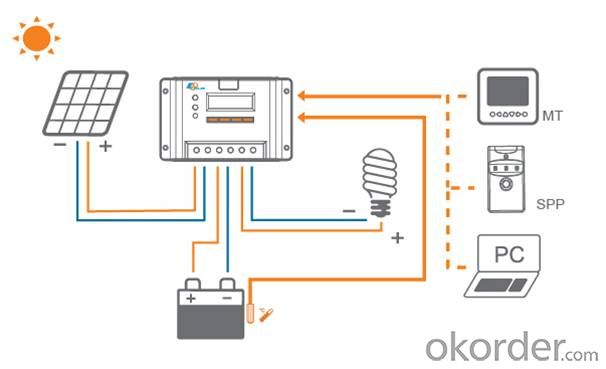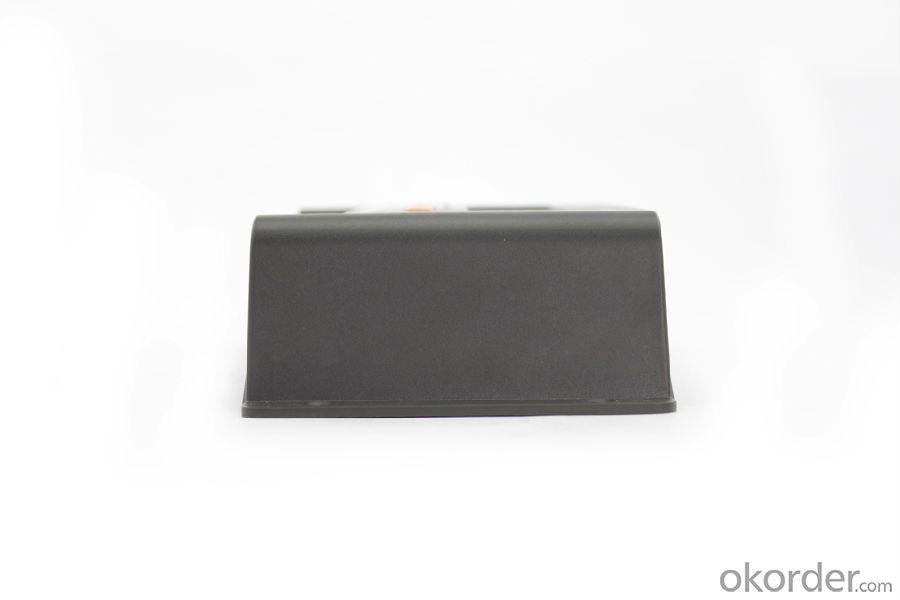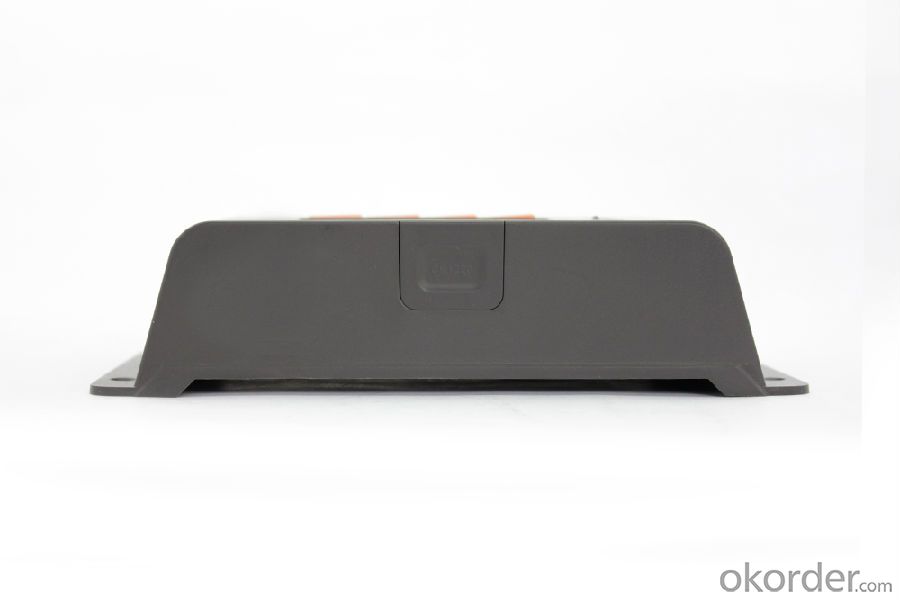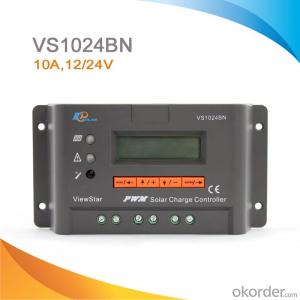Intelligent PWM Solar Charge Controller for Solar Street Light,10A,12V/24V,VS1024BN
- Loading Port:
- China main port
- Payment Terms:
- TT or LC
- Min Order Qty:
- -
- Supply Capability:
- -
OKorder Service Pledge
OKorder Financial Service
You Might Also Like
Features:
·Excellent EMC design
·32 bit MCU with high speed
·High efficient Series PWM charging
·Four battery type options: Sealed, Gel, Flooded, and USER
·Intelligent lighting and timer control for solar lighting system
·12 bit A/D high-precision sampling to ensure accuracy
·Use MOSFET as electronic switch
·Full control parameters setting and modification, diversified load control mode
·Humanized design of browser interface, undertake every operating conveniently
·Temperature compensation
·Adopt graphics dot-matrix LCD screen and HMI (human-machine interface) with 4 buttons,integrated menu displaying and operation
·Energy statistics function
·RS485 ports with MODBUS communication protocol
·Optional PC monitoring software and remote meter for real-time monitoring and battery management parameter setting
·Field upgradable firmware
Specification:
Model | VS1024BN | VS2024BN | VS3024BN | VS4524BN | VS6024BN |
Nominal system voltage | 12V/24V auto work | ||||
Rated battery current | 10A | 20A | 30A | 45A | 60A |
Rated load current | 10A | 20A | 30A | 45A | 60A |
Max. battery voltage | 32V | ||||
Equalize charging voltage | Sealed: 14.6V, Flooded: 14.8V, User-defined: 9~17V | ||||
Boost charging voltage | Gel: 14.2V, Sealed: 14.6V, Flooded: 14.8V, User-defined: 9~17V | ||||
Float charging voltage | Gel /Sealed /Flooded: 13.8V, User-defined: 9~17V | ||||
Low voltage reconnect voltage | Gel /Sealed /Flooded: 12.6V, User-defined: 9~17V | ||||
Low voltage disconnect voltage | Gel /Sealed /Flooded: 11.1V, User-defined: 9~17V | ||||
Self-consumption | ≤15mA(12V); ≤10mA(24V); ≤9mA(36V); ≤8mA(48V) | ||||
Grounding | Common negative | ||||
Temp. compensation | -3mV/°C/2V | ||||
Relative humidity | 10%~90% Non-condensation | ||||
Communication | RS485 / RJ45 interface | ||||
LCD temperature | -20°C ~ +70°C | ||||
Working temperature | -25°C ~ +55°C | ||||
Humidity | ≤95% N.C. | ||||
Enclosure | IP30 | ||||
Overall dimension | 162x85x40mm | 162x100x50mm | 200x103x58mm | 201x109x59mm | 205x129x67mm |
Terminals | 4mm2 | 10mm2 | 16mm2 | 35mm2 | 35mm2 |
Net weight | 0.2kg | 0.4kg | 0.7kg | 0.9kg | 1.3kg |
Warrenty
provides a 1~3 year limited warranty (“Warranty”) against defects in materials and workmanship for its Uninterruptible power supply,
Power inverter/chargers, Solar charge controllers, Battery Products (“Product”).
The term of this Warranty begins on the Product(s) initial purchase date, or the date of receipt of the Product(s) by the end user,
whichever is later. This must be indicated on the invoice, bill of sale, and/or warranty registration card submitted to MUST-Solar.
This Warranty applies to the original MUST-Solar Product purchaser, and is transferable only if the Product remains installed in the original use location.




FAQ:
Q1. What is the voltage?
A1. Our 45/60A solar charge controller is 12/24/36/48V auto work.
Q2. What is the difference between MPPT&PWM?
A2. MPPT has higher efficiency, it can track the max power point and won't waste energy.
Q3. What is the efficiency of the MPPT controller?
A3. MPPT>99%, peak conversion efficiency>98%.
Q4. What is the waranty of product?
A4. 12 months.
Q5. What protection does your MPPT controller have?
A5. PV array short circuit, PV reverse polarity, Battery reverse polarity, Over charging, Output short circuit.
- Q:Can a PWM solar controller be used with an MPPT solar panel?
- No, a PWM solar controller cannot be used with an MPPT solar panel. These two technologies are not compatible as they have different operating principles. PWM (Pulse Width Modulation) solar controllers regulate the voltage output from the solar panel by rapidly switching the panel's current on and off, resulting in a fixed voltage output. On the other hand, MPPT (Maximum Power Point Tracking) solar panels utilize advanced electronics to optimize the power output by continuously adjusting the voltage and current levels to extract maximum energy from the solar panel. Therefore, to maximize the efficiency and performance, it is recommended to use an MPPT solar controller with an MPPT solar panel.
- Q:What is the charging current rating of a solar controller?
- The charging current rating of a solar controller is the maximum amount of current it can handle while charging the batteries from the solar panels.
- Q:Can a solar controller be used with solar-powered remote data logging systems?
- Yes, a solar controller can be used with solar-powered remote data logging systems. A solar controller helps regulate the charging and discharging of batteries in a solar power system, ensuring optimal performance and preventing overcharging or damage. This is essential for remote data logging systems that rely on solar power to operate efficiently and sustainably.
- Q:Can a solar controller be used in a solar-powered electric airplane system?
- Yes, a solar controller can be used in a solar-powered electric airplane system. A solar controller is responsible for regulating the voltage and current from solar panels, ensuring efficient charging of batteries and protecting them from overcharging or discharging. In a solar-powered electric airplane system, the solar controller would play a crucial role in managing the power generated by the solar panels and ensuring optimal performance and safety of the system.
- Q:How does a solar controller prevent voltage instability in the system?
- A solar controller prevents voltage instability in a system by regulating and controlling the flow of electricity from the solar panels to the battery. It ensures that the voltage supplied by the solar panels matches the voltage requirements of the battery, thus preventing overcharging or undercharging. Additionally, a solar controller monitors the voltage and temperature of the battery and adjusts the charging process accordingly to maintain optimal performance and prevent any voltage fluctuations that could lead to instability in the system.
- Q:How does a solar controller prevent short-circuiting of solar panels?
- A solar controller prevents short-circuiting of solar panels by monitoring and regulating the flow of current from the panels to the battery or load. It ensures that the current does not exceed the maximum capacity of the panels, thus preventing any potential damage or short-circuiting that could occur from excessive current flow.
- Q:What is the purpose of the battery over-discharge protection feature on a solar controller?
- The purpose of the battery over-discharge protection feature on a solar controller is to prevent the battery from being discharged beyond a safe level. This feature helps to prolong the battery's lifespan and ensures that it remains in a healthy condition for optimal performance.
- Q:How does a solar controller prevent reverse current flow?
- A solar controller prevents reverse current flow by utilizing diodes that only allow current to flow in one direction, effectively blocking any reverse current from flowing back into the solar panels or batteries.
- Q:Can a solar controller be used with solar-powered indoor electric vehicle charging stations?
- Yes, a solar controller can be used with solar-powered indoor electric vehicle charging stations. A solar controller, also known as a charge controller, is designed to regulate the flow of electricity from solar panels to the battery bank. It ensures that the batteries are charged properly and prevents overcharging or discharging. In the case of indoor electric vehicle charging stations that are powered by solar energy, the solar controller plays a crucial role in managing the electricity generated by the solar panels. It ensures that the charging station receives the right amount of power and that any excess energy is properly stored in the battery bank for later use or fed back into the grid. By using a solar controller, the solar-powered indoor electric vehicle charging station can effectively harness and utilize solar energy, making the charging process more efficient and sustainable. The solar controller helps optimize the charging station's performance, ensuring reliable and clean energy for electric vehicle charging, even in indoor environments.
- Q:How does a solar controller handle shading or partial obstruction of solar panels?
- A solar controller handles shading or partial obstruction of solar panels by employing Maximum Power Point Tracking (MPPT) technology. This technology constantly monitors the voltage and current output of the solar panels and adjusts the operating conditions to optimize power generation. When shading occurs, the solar controller identifies the affected panels and dynamically adjusts the electrical connection to bypass the shaded area, ensuring that the unshaded panels continue operating at their maximum efficiency. This way, the solar controller minimizes the impact of shading or partial obstruction on the overall performance of the solar panels.
1. Manufacturer Overview |
|
|---|---|
| Location | |
| Year Established | |
| Annual Output Value | |
| Main Markets | |
| Company Certifications | |
2. Manufacturer Certificates |
|
|---|---|
| a) Certification Name | |
| Range | |
| Reference | |
| Validity Period | |
3. Manufacturer Capability |
|
|---|---|
| a)Trade Capacity | |
| Nearest Port | |
| Export Percentage | |
| No.of Employees in Trade Department | |
| Language Spoken: | |
| b)Factory Information | |
| Factory Size: | |
| No. of Production Lines | |
| Contract Manufacturing | |
| Product Price Range | |
Send your message to us
Intelligent PWM Solar Charge Controller for Solar Street Light,10A,12V/24V,VS1024BN
- Loading Port:
- China main port
- Payment Terms:
- TT or LC
- Min Order Qty:
- -
- Supply Capability:
- -
OKorder Service Pledge
OKorder Financial Service
Similar products
New products
Hot products
Hot Searches
Related keywords































